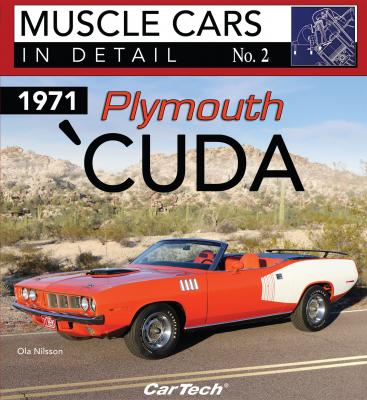ТОП просматриваемых книг сайта:
1971 Plymouth 'Cuda. Ola Nilsson
Читать онлайн.Название 1971 Plymouth 'Cuda
Год выпуска 0
isbn 9781613253809
Автор произведения Ola Nilsson
Жанр Автомобили и ПДД
Издательство Ingram
Standard Features
Drivetrain
New for 1971 Features
Sheet Metal and Body Changes
Ordering a 'Cuda
Engine Package Specs
Paint Colors
Interior Accommodations
Options
Model Year Production Changes
The Past
The Future
Around the World
Sales
Collectibles and Models
Registries
Lasting Legacy
Dana 9-3/4 and 8-3/4
Speedometer Pinion Gear Chart
Rear Axle and Engine Combinations
DEDICATION
To my beautiful daughter Emily. I hope that as she matures, she will understand my
passion for the Plymouth E-Body 'Cuda.
Enthusiasts, owners, historians, collectors of information, and specific individuals who share a devotion of research, these are the people to whom I would like to express my deep appreciation. Without your individual contributions to my long-term education on all things Plymouth E-Body, I would not be able to share this treasure of information to the next generation of enthusiast. Thank you all.
This Hemicuda with 4-speed transmission and 4.10 Dana 60 is 1 of 59 built for U.S. specifications. In-Violet Metallic paint code FC7, a white interior code H6XW and a white vinyl top code V1W combine to make a striking combination. Welcome to 1971! Note: the Sport Stripe was added during restoration of this exquisite beauty. (Wade Ogle Photo)
1971 Plymouth 'Cuda. One of the most recognized muscle cars in the United States automotive history. Styling. Horsepower. Aesthetics. Economic value. Whatever your attraction is to this amazing automobile, you cannot help but have respect for it. Most automobile enthusiasts can recognize it from far away. It is an extremely iconic and highly collectible automobile.
SHAKER hood. Billboard sport stripe. Gilled fenders. Elastomeric bumpers. Painted grille. Road Lamps. Front and rear spoiler package. Dual mirrors. Rear window louvers. Everything a person would want on a 1971 Plymouth 'Cuda and all the eye candy that these beautiful cars are known for. Just looking at it makes any person appreciate its beauty and styling. Plymouth designed, engineered, and built this car with quality in mind and to be the best car value. That is “Chrysler-Plymouth coming through for you.”
One of the key designers on the 1970 'Cuda was John Herlitz. In 1964 he was fresh out of the Pratt Institute in Brooklyn, New York where he majored in industrial design. Herlitz went straight from school to the Plymouth Production Design Studio, where his first project was to work on the second generation 1967 Barracuda. He brought along a new design that he did right out of college, although it was not used until the next model change. The problem with the all-new body Barracuda was that Plymouth could not find a manufacturing source with the capability to produce that kind of car. The plant was out of capacity. It even went so far as to consider buying Jaguar of England, but its way of producing cars simply would not work.
Chrysler Corporation knew that the “rollover” in the high-style segment of the market would take place over a three-year interval at the most. The corporation began designing the 1970 body style in the fall of 1967. Planning the release of the new body style for July 1969, it was designated the E-Body for that model year. The 1970 year was designated as F Series, but the E-Body designation remained throughout the following years because a major overhaul was necessary to change letter series.
Plymouth built identical promotion cars to be distributed in the many sales regions of the United States. These promo cars were highly optioned to showcase the new model features. All were painted in Curious Yellow paint code GY3. This stunning example has the lowest Vehicle Identification Number (VIN) and is believed to have been the first one built. (Kevin Kuypers Photo)
Another key designer of the E-Body was Fred Schimmel who was initially hired as a “Stylist B” in an entry-level position. He studied at the Art Institute of Chicago and San Antonio College and was hired by Chrysler right after graduation. He worked on the third generation (E-Body) Barracuda designs and was credited for the front of the 1970. Schimmel came up with the idea of fairing around the vertical bumper guards to cover the leaf spring shackles. He was also the final designer for the taillight treatment and most of the back end sheet metal. The 1971 taillights were taken from an idea created in 1968.
In-Violet Metallic paint code FC7 was ordered on approximately 7 percent of the 'Cudas built in 1971. Today this magnificent color is highly desired. An interesting option on this car is the wheel trim rings with hubcaps on the standard steel wheels. Very few were ordered with this option. (Rob and Danielle Polson Photo)
A unique look into the Plymouth design studio selection process. These images, dated December 10, 1968, are of a full-size working model for the designer to select features. One of the many design possibilities that was not used in production was a vent window on the door. (I’m glad about that.) Note the 1971 taillights. (Dodge, Plymouth and the AMC design are registered trademarks of FCA US LLC)
Plymouth designed one of the best looking hoods for any muscle car. Optioned with very few accessories, this 'Cuda440-6 built in Formal Black paint code TX9 is definitely not subtle. The small speaker installed in the dash pad was part of the AM/FM stereo radio code R35.

